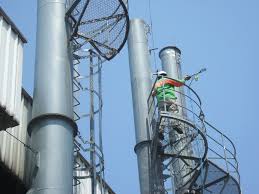Benefits of Stack Emission Testing
Stack Emission testing is the process of evaluation of those gases and their degree of presence in atmosphere from industries to meet environmental standards. Mostly every manufacturing or operating unit of a company has a chimney, which is called as stack. It emits polluted or wasted gas into the air which increases pollution. Results obtained from this testing process benefits companies to stay within environmental compliance.
Why Stack Emission Testing is Necessary?
Pollutants released in air needs to be monitored in order to:
- Meet the environmental standards
- Collect data for Emission records
- Provide data to Environmental Impact Assessment Surveys
- Measure process efficiency and process control
- For the process of Calibration of continuous emission monitors (CEMs)
- Study of efficiency of process change or newly installed pollution control equipment
To ensure representative sample in order to get accurate results, there are some standard processes needs to be followed (e.g. Isokinetic sampling etc.) in stack emission monitoring procedures.
Also Industries are required to submit stack emission monitoring reports to government bodies (Pollution control boards) on a regular basis.
You can refer to benefits of stack emission testing section for more info.
Read More about Stack emission monitoring equipment
Who Needs Stack Emission Monitoring?
Any company who emits pollutants from stack are required to carry out stack emission testing process. It is applied to stationary source emissions e.g. stacks of power plants, manufacturing units, Diesel generators, scrubbers, boilers etc.
Some companies are required to monitor levels of Hazardous air pollutants (HAPs) and Volatile Organic compounds (VOC).
Read More about Stack Emission Monitoring Services
Frequency of Stack Emission Testing
Stack monitoring frequency can differ for each industry. Some companies need to monitor weekly, monthly, bi-Monthly, quarterly, half yearly or yearly based on scale of emissions being discharged in environment.
Read More CPCB guidelines for Stack testing
Stack Emission Monitoring Parameters
The parameters for stack emission testing should have pollutants, flow rate and production during period of sampling
Common details and parameters for all types of industries:
- Diameter
- Height from ground level
- Temperature
- Velocity of flue gases
- Volume of flue gases
- Type of fuel
- TPM (Total particulate matter)
- SO2
- NOx
Other parameters based on type of industry
- CO2
- Fluorides
- CO
- HCl
- Heavy metals including mercury
- Moisture
Stack Emission Testing Report
After conducting stack emission testing procedure sample is sent to approved laboratory for further testing and After completion of tests and analysis stack emission testing report is created.
It should include following details:
- Name of the organization
- Address
- Date and time of sampling
- Source identification information
- Analysis Procedures
- Calculation procedures
- Calibration details of equipment used
- Summarizing the insights from Monitoring report
Benefits of Stack Emission Testing
Stack emission testing report can help companies to understand
- To determine types of pollutants and scale of pollutants are emitted by their unit is within permissible limits
- Scope to decrease pollutants by changing process
- Scope to reduce pollutants by changing or installing new pollution control equipment
- Study efficiency of stack and guidelines to improve it
Learn More about Benefits of Air Quality Testing
Stack Emission Testing Company
Perfect Pollucon services has vast experience in Stack emission testing along with The highly qualified and experienced staff can offer stack emission testing services.
In these many years our experts have done thorough research and have developed a sketch to efficiently deliver these benefits of stack emission testing services to our clients. We provide site assessment including health and safety for sampling sites.
Perfect Pollucon services offers environmental Services in India since 2007.

The only real reason for monitoring is to stay out of jail by showing you are doing what you say you will do in this era of ideological industry distrust and environmental litigation. There are no quantifiable health benefits obtained from monitoring. I wonder how many people die or are injured from the installation and operation of monitoring systems yearly as compared to the environmental benefits derived.